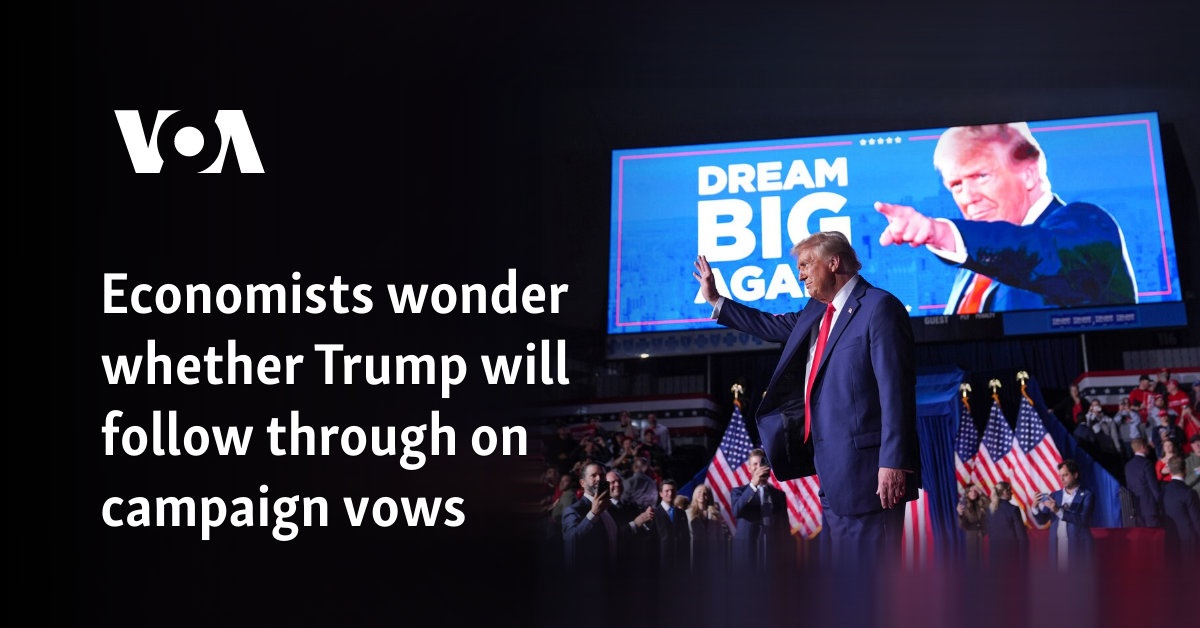
U.S. President-elect Donald Trump has left little question about the sort of economic policies he will pursue when he is sworn in for a second term as president in January.
The once-and-future president has promised to extend existing tax cuts and implement new ones; to pursue a deregulation agenda, particularly when it comes to energy production; to reinstate a strong protectionist trade policy, including substantial tariffs on imports; and to undertake a “mass deportation” program that would remove a large number of the millions of undocumented immigrants currently residing in the United States.
While there may be little doubt about the kind of policies Trump will implement, the degree to which he will pursue them is an open question.
“The problem that all economists are dealing with is they don’t know how much of what Trump said on the campaign trail to take seriously,” Steven B. Kamin, a senior fellow at the conservative-leaning American Enterprise Institute, told VOA. “They don’t know if he’s going to do a lot of these things, or if he is, how far he’ll take it.”
When it comes to tariffs, Trump has promised across-the-board 10%-20% levies on all imports, and charges of up to 60% on goods coming from China, which experts warn would be economically ruinous.
His rhetoric about fossil fuel extraction suggests he will drive up oil and gas production, even though the U.S. is currently producing more energy than it ever has.
On immigration, he and his advisers have vacillated between suggesting that all undocumented people will be forcibly removed and describing a much more targeted operation.
Tax policy
One thing that appears certain is that Trump will work with Congress — which seems likely to be fully controlled by the Republican Party — to extend the tax cuts that became law as part of the Tax Cuts and Jobs Act, which he signed into law in 2017.
Those tax cuts reduced the income taxes paid by many American workers and reduced taxable income by increasing the standard deduction. They also sharply cut the top business income tax bracket from 39% to 21%. Those provisions are all scheduled to expire over the next several years, some as soon as 2025, and Trump has proposed making them permanent.
Trump has also floated the idea of other tax cuts, including further reducing the business income tax to a maximum of 15%, and making income from overtime wages, tips and Social Security payments nontaxable, all of which would reduce government revenues.
Kamin said the stimulative impact of Trump’s proposed additional tax changes would likely not be great, but the impact on the country’s debt might be, because they will virtually guarantee additional government borrowing to finance deficit spending.
“The real concern for folks that are concerned about the fiscal balance — and I’m one of them — is that by cementing in place large fiscal deficits as far as the eye can see, even in environments of strong economic activity when we should be running surpluses, that leads to increases in the debt,” he said.
“That, eventually, should lead to crowding out of private investment, rising interest rates, and more worries about the government’s sustainability position,” Kamin added. “But when the debt will reach a level that will be worrisome in that respect, nobody knows.”
Cost-cutting
In theory, some of the deficit spending made necessary by large tax cuts could be offset by a reduction in government spending, something Trump has also floated on the campaign trail.
In particular, the president-elect has proposed creating a Department of Government Efficiency, to be headed by Elon Musk, the billionaire founder of the electric car company Tesla and the rocket builder SpaceX, and the owner of X, the social network formerly known as Twitter.
For his part, Musk has mused that it should be possible to slash federal spending by as much as $2 trillion per year, or about 30%.
Reductions of that magnitude would require deep cuts to a vast array of programs, including elements of the social safety net such as Social Security and federal health programs like Medicaid. However, it is unclear how Trump would persuade even a Republican Congress to enact such a wide-ranging reduction in government services.
Immigration policy
If Trump follows through on a policy of mass deportation of undocumented immigrants, it is virtually certain to have a negative impact on economic sectors where they are present as laborers in significant concentrations, especially agriculture and construction, said Marcus Noland, executive vice president and director of studies at the Peterson Institute for International Economics.
“If you take lots of people out of the labor force, you reduce the amount of output, because there’s less labor available, and you raise prices,” Noland told VOA.
“These people are not distributed evenly across the United States economy,” he said. “They’re concentrated in agriculture and construction, so you would disrupt those sectors the most, especially if you combine it with tariffs.”
Trade policy
Trump’s tariff proposals, especially if he follows through with his maximalist proposals from the campaign trail, could be significantly damaging. While theoretically meant to stimulate American manufacturing, Noland warned that they could have the opposite effect.
“Some modeling that I worked on suggest that those tariff policies, instead of reviving the industrial sector, will actually reduce industrial activity in the United States,” he warned.
Blanket tariffs on imports, and especially high levies on Chinese goods, would create severe challenges for U.S. manufacturers.
“The reason is that you would increase the price of industrial inputs, and so, the United States would become a high-cost place to produce,” he said. “Investment would fall — and investment is intensive in industrial materials — so, ironically, it has the opposite effect of what its proponents say.”
This post was originally published on here







